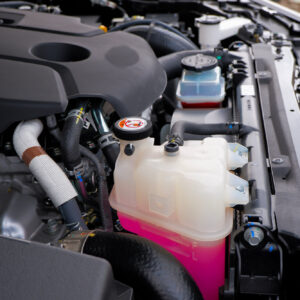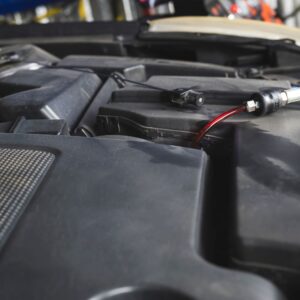Most vehicles are designed to make it through the winter, but that doesn’t mean they don’t need a little TLC when the snow starts to melt. With icy cold nights now behind you, it’s time to check on several vehicle systems, including your transmission.
How Does Cold Weather Affect Your Transmission?
No vehicle is immune to the cold, especially when it’s exposed to long winter nights. Here are some ways extreme cold weather can damage your ride:
Shrunken Rubber Seals and Gaskets
Low temperatures can cause your transmission’s rubber seals and gaskets to shrink, leading to cracked or worn rubber. Not only can this lead to transmission fluid leaks, it also opens your transmission to water, dirt, and other contaminants.
Dirty transmission fluid compromises its cooling abilities, which means it’s very likely for your transmission to overheat. An overheating transmission can damage other parts of your vehicle, including the engine.
Fixing Shrunken Rubber Seals and Gaskets:
Replace worn rubber seals and gaskets right away. If you aren’t sure how to replace your transmission seal or gasket by yourself, don’t hesitate to ask a mechanic for help.
Thick Transmission Fluid
The winter can mess with your transmission fluid’s viscosity, making it much thicker than it should be. Thick transmission fluid has a hard time lubricating the gears and other parts of your transmission. This can damage your gearbox and cause its parts to wear faster.
Fixing Thick Transmission Fluid:
If you live somewhere cold, check your transmission fluid level regularly. This way, you can make sure that your transmission is always good to go. The process of checking your transmission fluid can vary depending on your vehicle’s year, make, and model, but it usually involves checking your transmission dipstick.
Water in Your Transmission
Water and transmission are two things that should never meet. When water enters the gearbox, it can cause several parts to wear and eventually lead to a malfunctioning transmission. The good thing is that transmission systems are designed to make sure water can’t just get in. Unfortunately, they aren’t invincible.
Worn seals and cracked gaskets can allow water to enter the transmission and cause corrosion. During extremely cold days, all that water can freeze and cause your gearbox to crack.
Getting Rid of Water in Your Transmission:
Try warming up your vehicle before driving. This can help prevent water from freezing in your transmission, but it isn’t a long-term solution. As soon as you notice puddles of transmission fluid or water under your vehicle, bring your car to a mechanic.
Shifting Problems for Automatic Transmissions
If you drive an automatic vehicle, then you might’ve noticed your gears shifting slower than usual. This is likely due to thick transmission fluid and low fluid pressure, which can both be caused by cold weather.
Slipping gears is also a common issue during the winter. A low transmission temperature can cause several parts to contract, causing gears to slip more often.
Fixing Shifting Issues for Automatic Transmissions:
In most cases, shifting issues should go away once the transmission fluid’s temperature goes up. You can do this by warming up your vehicle while idling before you drive away.
If the weather has warmed up and your transmission is still shifting slowly, then it’s probably time to visit your mechanic.

Taking Care of Your Transmission When It’s Cold
You don’t have to wait until winter’s over before taking care of your transmission. Here are a few ways you can protect your transmission when it’s cold:
Driving Slowly
As much as possible, avoid driving too fast when it’s cold. Let your transmission fluid and internal parts warm up during the first few miles to avoid damaging your transmission.
Parking Your Vehicle Indoors
Parking your vehicle indoors is a great way of protecting your car from the harsh cold weather. If you don’t have a garage, try parking at a covered parking spot. Even if it isn’t completely enclosed, it’s much better than leaving your car out in the open.
It’s also a good idea to invest in protective accessories, such as a car cover. While a car cover is usually for outside parking, you can use it even while your vehicle is parked indoors. It’ll add another layer of protection and help the transmission warm up much faster.
Investing in an Engine Heater
Using an engine heater is a great way to keep your vehicle warm. Most engine heaters are easy to use. All you have to do is plug one into an outlet, and a timer should go off, letting you know when it’s reached its optimal temperature.
Using Synthetic Transmission Fluid
You can find synthetic transmission fluids that are better suited for cold weather. However, not every vehicle can handle synthetic fluid, so be sure to check if it’s compatible with your car’s specific year, make, and model before you use it.
What Is the Normal Transmission Temperature?
The optimal temperature for the transmission will vary depending on your vehicle’s year, make, and model. However, the average transmission temperature ranges from 175°F to 200°F.
How To Check Your Transmission’s Temp
There are several ways to check your transmission’s temperature. Here are a few examples:
Using a Transmission Temperature Gauge
Nowadays, most vehicles come with built-in dashboard gauges that display the transmission’s temperature in real time. This is a great way to monitor your transmission during the cold winter days.
Using a Scan Tool
If you have a scan tool, you can also use it to check your transmission temperature. It’s usually easy to use and shows accurate results.
Using a Handheld Infrared Thermometer
You can also use a handheld infrared thermometer to check your transmission temperature. Point the thermometer at the transmission oil pan to see your transmission’s temperature.
However, the environment can also influence the temperature reading, so this method might not always be accurate.
Low Transmission Temperature vs. Low Pressure
Low transmission temperature is different from low pressure, but keep in mind that both are equally dangerous for your vehicle.
Fluid leaks and contaminated transmission fluid are the main reasons why low fluid pressure occurs in the transmission.
When there isn’t enough pressure inside the transmission, you’ll notice that the gears are harder to shift. In some cases, this might hinder you from switching to a higher gear. There’s also a possibility for the transmission to overheat and for the vehicle to get stuck in limp mode.
Also, low transmission fluid pressure can cause the vehicle computer to log a diagnostic trouble code (DTC) like a P0868 code.
Low air pressure is another issue that you might come across with your vehicle. In most cases, faults in the air system can cause this problem to arise.
Excessive use or cycling of the service brake can exhaust the vehicle’s air supply, creating the same issue.
Get New Transmission Gaskets and Seals Delivered To You
The gaskets and seals in your transmission will eventually need to be replaced. If they wear out or fail, they can cause low transmission temperatures and other issues. Whether you need a transmission seal or a transmission gasket, you can get them quickly and easily at CarParts.com.
CarParts.com delivers transmission gaskets, transmission seals, and other automotive parts to where you need them. Our strategically located distribution centers allow us to ship your new part to where it needs to go. If you live anywhere in the continental US and order by noon ET, your replacement transmission part can reach you in several business days. You can rest assured that your new gasket or seal will perform as expected because we exclusively source our products from brands trusted by drivers across the US. If you have questions about our transmission gaskets and transmission seals, you can contact our customer service team any time.
Make CarParts.com your one-stop shop for high-quality transmission gaskets and seals at prices you can’t beat. Browse our selection of transmission gaskets and transmission seals and order today.
Any information provided on this Website is for informational purposes only and is not intended to replace consultation with a professional mechanic. The accuracy and timeliness of the information may change from the time of publication.
































